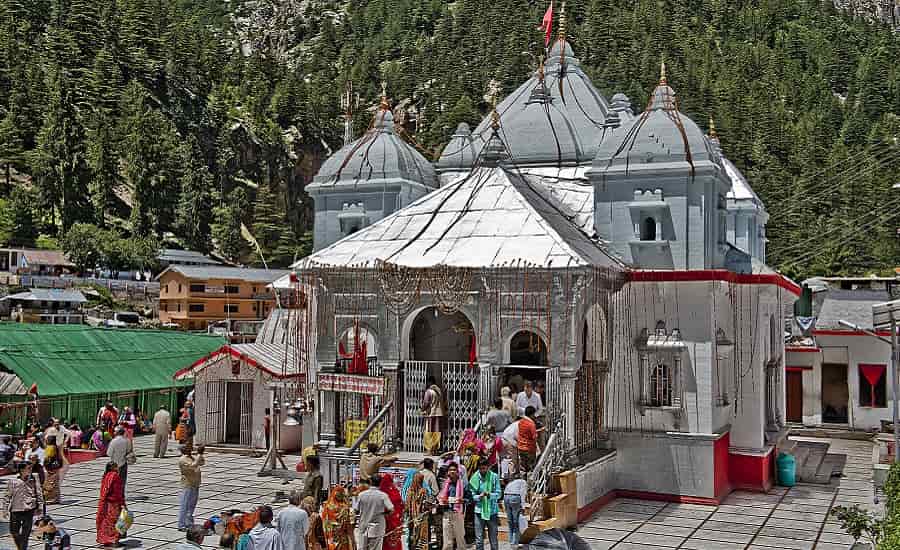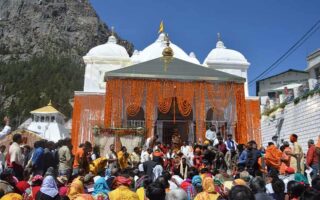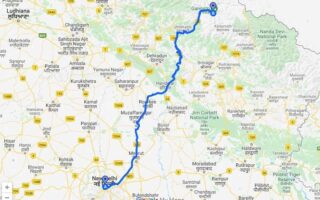Gangotri is the second destination in the char Dham Yatra in Uttarakhand. One of the holiest of temples dedicated to Goddess Ganga, it is associated with myths and legends that make for interesting reading.
History of Gangotri
The present day temple is said to have been built by General Amar Singh Thapa in the 18th century. It is believed that Goddess Ganga descended from the Heavens to the Earth on this sacred spot, flowing through the matted locks of Lord Shiva and distributing herself into five tributaries that ultimately confluence into the Ganga River.

Legends & Mythological Story
King Bhagiratha meditated for a long time and wanted to bring Ganga Goddess down to the Earth so that she could wash away the sins of his predecessors. His predecessors were King Sagar who had 60,000 sons born to Queen Sumati. King Sagar killed the demons and planned on an Ashwamedh Yagya, with the sacrificial horse to be taken around the Earth by Asamanja, born to his queen Kesani. Lord Indra decided to foil his plan and stole the horse that he tied at the doorstep of Kapil Muni. Kapil Muni was meditating and when the sons of King Sagar found the horse outside his hermitage they assumed he was the thief. Kapil Muni opened his eyes and the 60000 sons were instantly killed. King Bhagiratha, the grandson of King Sagar, planned to perform penance and bring down Ganga to wash away the sins of the 60,000 sons so that they could ascend to heaven. The goddess was pleased and agreed to descend. However, Lord Shiva know that her mighty force would destroy the Earth so he received her in his matted locks and broke the force. Because she was brought to Earth by King Bhagirath, she is also known as Bhagirathi and the River is named after her.
Another story goes like this: Ganga was a beautiful woman born from the water vessel of Lord Brahma. The water in the vessel was collected after Brahma washed the feet of Lord Vishnu who had killed the demon Bali. Therefore, Ganga is also known as Vishnupadi. Vishnu, in his avatar of Vamana, asked Bali for three footsteps. On one step he places his foot on the Earth, on the second he places his foot on the Sky and the third step is placed on Heaven. However, Vamana stubs his to on Heaven and releases Vishnupadi who streams her way across the sky and appears as a Polestar and the milky way after which she arrives on the moon and then down to earth on a divine lotus on Mount Meru. This version is different from the one where she descends on the matted locks of Lord Shiva at the request of King Bhagiratha. Once Ganga arrives, King Bhagiratha leads her to Haridwar, goes on to meet Yamuna at Prayag and flows into Ganga Sagar and down into the netherworld where she saves the sons of King Sagara and King Bhagiratha’s wishes are fulfilled.
If she is descended from Heaven, then she is also the pathway up to heaven for people who bathe in her holy waters. Dying on the banks of the Ganga at Varanasi is said to take you to heaven. Ideally, devout Hindus would bathe at Haridwar and then proceed to Gangotri, considering the route as the route to salvation.
Yet another story states that Ganga descended to Earth and married King Shantanu, one of the ancestors of the Pandavas. They had seven children, all of whom were thrown into the river. However, Bhishma (Bheeshma), the eighth, was spared because King Shantanu rescued him. This displeased Ganga who left him.
The temple aptly opens in April/May when Hindus celebrate the descent of Ganga to Earth on the day known as Ganga Dussehra.
Ganga is considered Brahma’s consort, since she travelled in his water pot. She is considered Vishnu’s consort since she emanates from his foot. Along with Saraswati and Lakshmi, she became one of his wives. Saraswati and Ganga used to fight and cursed each other to become rivers and wash away sins of human worshippers. Lord Vishnu intervenes and orders Saraswati to be the wife of Brahma and Ganga to be the consort of Lord Shiva while he retained Lakshmi. They both protest and Vishnu had to take them back. Shiva received her in his matted locks and is also known as Gangadhar. Ganga is Shakti, always moving, never still, a divine form of energy. Ganga represents supreme Shakti of Shiva, full of compassion and sweetness, forgiving and understanding, a typical mother. Interestingly, she received the fiery seed of Shiva from Agni, the fire god and produced Karthikeya, the God of War. She is also the mother of Bhishma, the fount of wisdom. Ganga is the universe. Divine, worthy of worship and reverence of all Hindus.


